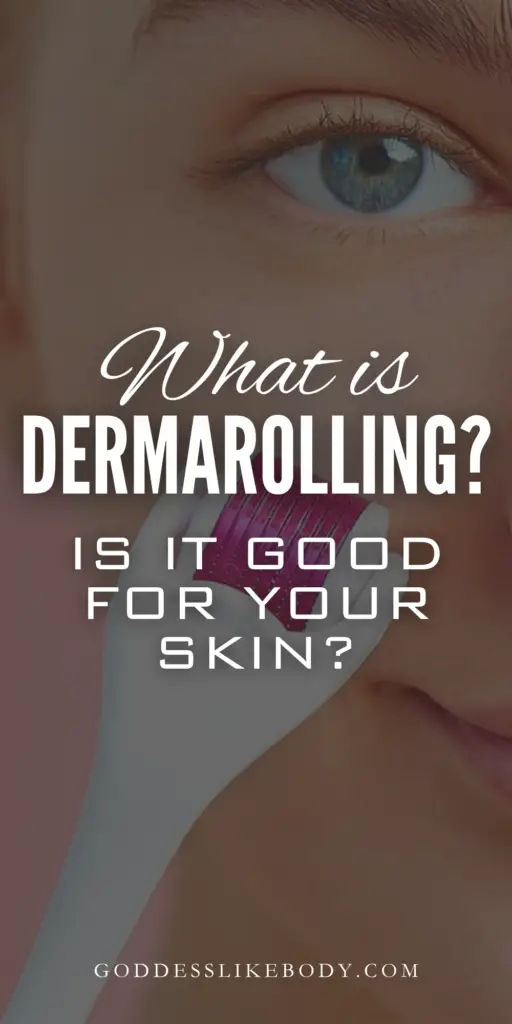Dermarolling, also known as microneedling or collagen induction therapy, is a popular skincare treatment that involves using a specialized device called a dermaroller to create tiny punctures in the skin.
These punctures stimulate the body’s natural healing process and promote the production of collagen and elastin, two essential proteins for maintaining healthy and youthful skin.
In this post, we will delve deeper into the world of dermarolling, exploring its benefits, potential risks, and how it can improve the overall health and appearance of your skin.
Busy? Save this pin for later.
The Science Behind Dermarolling
Dermarolling works on the principle of controlled skin injury. When the tiny needles on the dermaroller penetrate the skin’s surface, they create microscopic channels that trigger the body’s wound healing response.
This response involves the release of growth factors and the production of collagen and elastin, which are essential for skin rejuvenation.
By creating these micro-injuries, dermarolling stimulates the body’s natural healing mechanisms. The release of growth factors and the production of collagen and elastin help to repair damaged skin cells and promote the growth of new, healthy cells.
This process not only improves the texture and tone of the skin but also helps to reduce the appearance of fine lines, wrinkles, and acne scars.
Additionally, dermarolling can also enhance the absorption of skincare products. The micro-channels created by the dermaroller allow serums, moisturizers, and other products to penetrate deeper into the skin, maximizing their effectiveness. This increased absorption can significantly enhance the results of your skincare routine.
Benefits of Dermarolling
1. Improved Skin Texture and Tone
One of the primary benefits of dermarolling is its ability to enhance skin texture and tone. By promoting collagen and elastin production, dermarolling can minimize the appearance of fine lines, wrinkles, and acne scars.
The increased production of these proteins helps to strengthen the skin’s structure and improve its overall elasticity. This, in turn, leads to a smoother and more youthful complexion.
To further improve skin texture and tone, dermarolling can also stimulate the production of hyaluronic acid.
Hyaluronic acid is a natural substance found in the skin that helps to maintain moisture levels and promote a plump and hydrated appearance.
By increasing the production of hyaluronic acid, dermarolling can further improve skin texture and give it a radiant and healthy glow.
You Might Also Like: Skincare Mistakes You Might Be Making (and How to Fix Them)
2. Increased Product Absorption
Dermarolling enhances the absorption of skincare products by creating micro-channels in the skin. This allows serums, moisturizers, and other products to penetrate deeper into the skin, maximizing their effectiveness.
The micro-channels created by the dermaroller also help to increase blood circulation in the treated area, which further aids in the delivery of nutrients and oxygen to the skin cells.
To make the most of this increased product absorption, it is important to choose high-quality skincare products that are specifically formulated to work in synergy with dermarolling.
Look for products that contain ingredients such as hyaluronic acid, vitamin C, and peptides, as these can further enhance the benefits of dermarolling and promote healthier, more radiant skin.
3. Reduction in Hyperpigmentation
Hyperpigmentation refers to areas of the skin that are darker than the surrounding skin tone, often caused by sun damage, acne scars, or hormonal changes.
Dermarolling can help fade hyperpigmentation by promoting the turnover of skin cells and encouraging the growth of new, healthy cells.
The microscopic channels created by the dermaroller stimulate the skin’s natural exfoliation process, helping to remove the top layer of pigmented cells and reveal fresher, more evenly-toned skin.
To further enhance the reduction of hyperpigmentation, consider incorporating brightening ingredients into your skincare routine.
Ingredients such as vitamin C, niacinamide, and kojic acid can help to inhibit the production of melanin, the pigment responsible for dark spots and uneven skin tone.
When used in conjunction with dermarolling, these ingredients can help to achieve a more even and luminous complexion.
4. Minimized Pore Size
Enlarged pores can be a common concern for many individuals. Dermarolling can help minimize the appearance of pores by stimulating collagen production and tightening the skin.
As the skin becomes more elastic and firm, the size of the pores decreases, resulting in a smoother and more refined complexion.
To further improve the appearance of pores, incorporate pore-refining ingredients into your skincare routine. Ingredients such as salicylic acid and niacinamide can help to unclog pores, reduce excess oil production, and promote a clearer complexion.
When combined with dermarolling, these ingredients can help to achieve a more refined and even skin texture.
You Might Also Like: How to Create an Anti-Aging Skincare Routine
5. Improved Hair Growth
Dermarolling is not limited to facial skincare; it can also be used on the scalp to stimulate hair growth. The tiny punctures made by the dermaroller promote blood circulation to the hair follicles, nourishing them and encouraging hair regrowth. This can be particularly beneficial for individuals experiencing hair thinning or alopecia.
To enhance the benefits of dermarolling for hair growth, consider using hair growth serums or oils that contain ingredients such as biotin, castor oil, and caffeine.
These ingredients have been shown to promote hair growth and strengthen the hair follicles. When used in conjunction with dermarolling, they can help to achieve thicker, fuller, and healthier-looking hair.
Proper Dermarolling Technique
To ensure the best results and minimize any potential risks, it is important to follow the proper dermarolling technique:
Choose the Right Needle Length: The needle length of your dermaroller depends on the specific skin concern you wish to address.
Shorter needles (0.25mm-0.5mm) are suitable for improving product absorption and enhancing overall skin texture. Longer needles (0.5mm-1.0mm) are typically used to target scars, hyperpigmentation, and hair regrowth.
It is crucial to consult with a skincare professional to determine the appropriate needle length for your specific needs.
Prepare Your Skin: Start by thoroughly cleansing your skin and sanitizing the dermaroller to avoid any potential infection. You may also apply a numbing cream if desired, as dermarolling can cause some discomfort.
Rolling Technique: Gently roll the dermaroller vertically, horizontally, and diagonally over the desired area. Apply light pressure to avoid causing unnecessary trauma to the skin.
It is essential to roll in one direction at a time and avoid excessive rolling in the same area, as this can lead to irritation.
Post-Treatment Skincare: After dermarolling, apply a soothing serum or moisturizer to calm and hydrate the skin. Avoid using any harsh or irritating products immediately after the treatment, as the skin may be more sensitive.
To maximize the benefits of dermarolling, it is recommended to incorporate it into your skincare routine once every 4-6 weeks, depending on your skin’s tolerance and the specific concerns you are addressing. Consistency is key in achieving optimal results.
Potential Risks and Precautions
While dermarolling can yield remarkable benefits, it is essential to be aware of the potential risks and take necessary precautions. Some considerations include:
Skin Irritation and Sensitivity: After dermarolling, you may experience mild redness, swelling, and sensitivity. These side effects are typically temporary and subside within a few hours to a few days.
It is crucial to protect your skin from sun exposure and avoid using harsh skincare products during the recovery period.
Infection Risk: Proper sterilization of the dermaroller is crucial to prevent infections. Ensure that your dermaroller is clean and free from any debris or bacteria before each use.
If you have any active skin infections, it is advisable to avoid dermarolling until the infection has cleared.
Skin Conditions and Pregnancy: Individuals with certain skin conditions, such as eczema, rosacea, or active acne, should consult with a dermatologist before trying dermarolling.
Additionally, pregnant or breastfeeding individuals should avoid this treatment, as there is limited research on its safety during these periods.
Conclusion
Dermarolling is a promising skincare treatment that can offer significant benefits for your skin’s health and appearance.
By stimulating collagen and elastin production, dermarolling can improve skin texture, reduce hyperpigmentation, and enhance the absorption of skincare products.
However, it is crucial to follow proper technique and take necessary precautions to ensure safe and effective results.
If you have any concerns or specific skin conditions, it is always advisable to consult with a skincare professional before incorporating dermarolling into your routine.
Remember, healthy and beautiful skin takes time and consistency, so be patient and diligent in your skincare journey.
You Might Also Like: How To Make Face Mask At Home Easily
FAQ
1. What is dermarolling?
Dermarolling, also known as microneedling or collagen induction therapy, is a skincare treatment that involves using a dermaroller to create tiny punctures in the skin.
These punctures stimulate the body’s natural healing process and promote the production of collagen and elastin, which are essential for healthy and youthful skin.
2. What are the benefits of dermarolling?
Dermarolling offers several benefits for the skin, including improved texture and tone, increased product absorption, reduction in hyperpigmentation, minimized pore size, and improved hair growth.
3. How does dermarolling work?
Dermarolling works by creating micro-injuries in the skin, which trigger the body’s natural healing response.
This response involves the release of growth factors and the production of collagen and elastin, which help repair damaged skin cells and promote the growth of new, healthy cells.
Dermarolling also enhances the absorption of skincare products by creating micro-channels in the skin.
4. What are the potential risks and precautions of dermarolling?
While dermarolling can yield remarkable benefits, there are some potential risks to be aware of. These include skin irritation and sensitivity, infection risk (if the dermaroller is not properly sterilized), and certain precautions for individuals with specific skin conditions or during pregnancy and breastfeeding.
It is important to consult with a skincare professional and follow proper technique and precautions to ensure safe and effective results.




Leave a Reply
You must be logged in to post a comment.